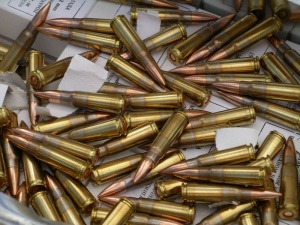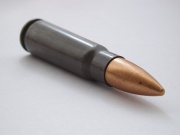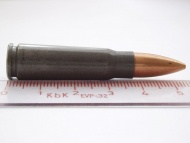7.62x39mm
| 7.62x39mm | |||||||||||||
|---|---|---|---|---|---|---|---|---|---|---|---|---|---|

| |||||||||||||
| Yugoslavian version of the 7.62x39mm cartridge, designated M67. It has a flat based lead core projectile. | |||||||||||||
| Type | Rifle | ||||||||||||
| Country of Origin | Soviet Union | ||||||||||||
| Specifications | |||||||||||||
| Case Type | Rimless, bottleneck | ||||||||||||
| Bullet Ø | 7.90 mm (0.311 in) | ||||||||||||
| Neck Ø | 8.64 mm (0.340 in) | ||||||||||||
| Shoulder Ø | 10.01 mm (0.394 in) | ||||||||||||
| Base Ø | 11.25 mm (0.443 in) | ||||||||||||
| Rim Ø | 11.30 mm (0.445 in) | ||||||||||||
| Case Length | 38.65 mm (1.522 in) | ||||||||||||
| Full Length | 55.80 mm (2.197 in) | ||||||||||||
| Primer | Berdan or Boxer Small Rifle or Boxer Large Rifle | ||||||||||||
| Filling | SSNF 50 powder | ||||||||||||
| Filling Wt. | 24.7 gr | ||||||||||||
| Production & Service | |||||||||||||
| Designer | Red Army | ||||||||||||
| Design Date | 1943 | ||||||||||||
| Manufacturer | innumerable | ||||||||||||
| Production Dates | 1943–present | ||||||||||||
| In Service | 1945–present | ||||||||||||
| Used By | Soviet Union, Warsaw Pact, People's Republic of China, Cambodia, North Korea, Vietnam, Finland, Venezuela | ||||||||||||
| Wars | too many to list | ||||||||||||
| Ballistic Performance Sampling | |||||||||||||
| |||||||||||||
The Soviet 7.62x39mm rifle cartridge was designed during World War II and first used in the SKS carbine. The cartridge was likely influenced by a variety of foreign developments, especially the pre-war German GeCo, 7.75x39mm experimental round,[3] and possibly by the late-war German 7.92x33mm Kurz ("Kurz" meaning "short" in German). Shortly after the war, the world's most recognized assault rifle was designed for this cartridge: the AK-47. The cartridge remained the Soviet standard until the 1970s, and is still one of the most common intermediate rifle cartridges used around the world. Its replacement, the 5.45x39mm cartridge, is slightly less powerful but is more controllable in fully automatic fire due to the lower recoil. The change was in part a response to NATO switching from the 7.62x51mm NATO cartridge to 5.56x45mm NATO.
Contents[hide] |
[edit] History


The original Soviet M43 bullets are boat-tail bullets with a copper-plated steel jacket, a large steel core, and some lead between the core and the jacket. The cartridge itself consists of a berdan-primed, tapered (usually steel) case which seats the bullet and contains the powder charge. The taper makes it very easy to feed and extract the round, since there is little contact with the chamber walls until the round is fully seated. This taper is what causes the AK-47 to have distinctively curved magazines. While the bullet design itself has gone through a few redesigns, the cartridge itself remains largely unchanged.
[edit] M43
Although the new cartridge represented a great leap forward from previous designs, the initial bullet design was flawed. The complete solidity of the M43 projectile causes its only drawback—it is stable even in tissue and begins to yaw only after traversing nearly 30cm of tissue. This greatly reduces the wounding effectiveness of the projectile against humans. Dr. Martin Fackler noted that the wounds from the M43 round were comparable to that of a small handgun round using non-expanding bullets. Unless the round struck something vital, the wound was usually small and healed quickly.
[edit] M67
In the 1960s the Yugoslavians experimented with new bullet designs to produce a round with a superior wounding profile, speed, and accuracy to the M43. Dr. Fackler also evaluated the M67 in the same manner that he evaluated the M43. The M67 projectile is shorter and flatter-based than the M43. This is mainly due to the deletion of the mild steel insert. This has the side effect of shifting the center of gravity rearward in comparison to the M43. This allows the projectile to destabilize nearly 17cm earlier in tissue. This causes a pair of large stretch cavities at a depth likely to cause effective wound trauma. When the temporary stretch cavity intersects with the skin at the exit area, a larger exit wound will result, which takes longer to heal. Additionally, when the stretch cavity intersects a stiff organ like the liver, it will cause damage to that organ.
However, without fragmentation, the wounding potential of M67 is mostly limited to the small permanent wound channel the bullet itself makes. While a fragmenting round (like the 5.56x45mm NATO) might cause massive tissue trauma and blood loss (and thus rapid incapacitation) on a lung or abdominal hit, the M67 has a greater chance of merely wounding the target. However, the 5.56x45 will only reliably fragment in close ranges below 125 meters.
[edit] Chinese steel core
Chinese military-issue ammunition in this caliber is M43 style with a mild steel core and a thin jacket of copper or brass. Contrary to common belief, the use of steel was a cost saving measure rather than one to increase penetration. Additionally, mild steel is not sufficiently hard to grant unusual armor penetrating capability. Despite this, Chinese ammunition is currently banned from importation in the US because there are 7.62x39mm caliber handguns and the ammunition is an armor-piercing handgun round under the U.S. federal legal definition of the word, which is based on materials and bullet design rather than on tested ability to penetrate armor. [4]
[edit] Ballistics
The standard AK-47 or AKM fires a 7.62x39mm round with a muzzle velocity of 710 metres per second (2,329 ft/s). Muzzle energy is 2,010 joules (1,467 ft·lbf). Cartridge case length is 38.6 millimetres (1.5 in), weight is 18.21 grams (281.0 gr). Projectile weight is normally 8 grams (123 gr). The AK-47 and AKM, with the 7.62x39mm cartridge, have a maximum effective range of around 400 meters.[edit] Other names for 7.62x39mm

On some occasions, this ammunition is referred to as 7.62 mm Soviet, 7.62 mm Warsaw Pact, or 7.62 mm ComBloc. It was also known in the United States as .30 Short Russian/ComBloc; the "Short" was to distinguish it from the older .30 Russian, which was the 7.62x54mmR. (Note that the "R" in 7.62x54mmR does not stand for "Russian", but "Rimmed".)
[edit] Hunting and Sport Use
Since approximately 1990, the 7.62x39mm cartridge has seen some use in hunting arms in the US for hunting game up to the size of whitetail deer, as it is approximately as powerful as the old .30-30 Winchester round, and has a similar ballistic profile.[5] Large numbers of inexpensive imported semiautomatic rifles, like the SKS and semi-auto AK-47 clones and variants, are available in this caliber. The SKS is so inexpensive as to have begun displacing the .30-30 lever-action rifles as the new "poor man's deer rifle" by being less expensive than the .30-30 Marlins and Winchesters that long held that role. In addition, Ruger produces the Mini-30 as a 7.62x39mm version of their popular Mini-14 rifles. Inexpensive imported 7.62x39mm ammunition is also widely available, though much of it is of the non-expanding type that may be illegal to use for hunting in some US states. However, both imported Russian ammunition like Wolf brand and American civilian manufacturers produce both hollow-point and soft-point rounds, which are suitable and nearly universally legal for hunting except in areas where the use of rifles for hunting is completely prohibited.
7.62x39mm ammunition has typically been inexpensive, one of the least-expensive centerfire rifle ammunition on the market at just over 10 cents a round for high-quality imported Russian brands and now 17 cents a round for quality imported ammo after a sharp price rise on mil-spec ammo in this caliber in early 2006, though as of late 2007 it is reaching the 20 cents per round level in the US. It is cheaper than most handgun rounds and even some expensive target .22 rimfire ammunition. However, in 2005/2006, prices began to soar (almost doubling in the US) due to the United States placing a massive order to supply the fledgling Afghan and Iraqi armies.[6] Even so, as of January 2007, it remains among the least expensive centerfire rifle ammo on the market. This cartridge has endeared itself to shooters in spite of its limited ballistics, because of the many inexpensive good semiautomatic rifles available for it, the availability of inexpensive ammunition, and because of its minimal recoil. Average price in early 2008 has risen only to 22 cents per round, bought in bulk packs of 500 to 1000.
[edit] See also
[edit] References
- ↑ The 7.62x39mm M43
- ↑ Wolf Rifle Ammo
- ↑ Origin of AK Assault rifle and 7.62x39mm cartridge
- ↑ US Code: Title 18, Part 1, Chapter 44, § 921
- ↑ "CZ Mod 527 (7.62x39mm)", theothersideofkim.com, retrieved 20 October 2007.
- ↑ "US sets up £215m deal for Afghan arms - from Russia", telegraph.co.uk, retrieved 2 October 2006.
